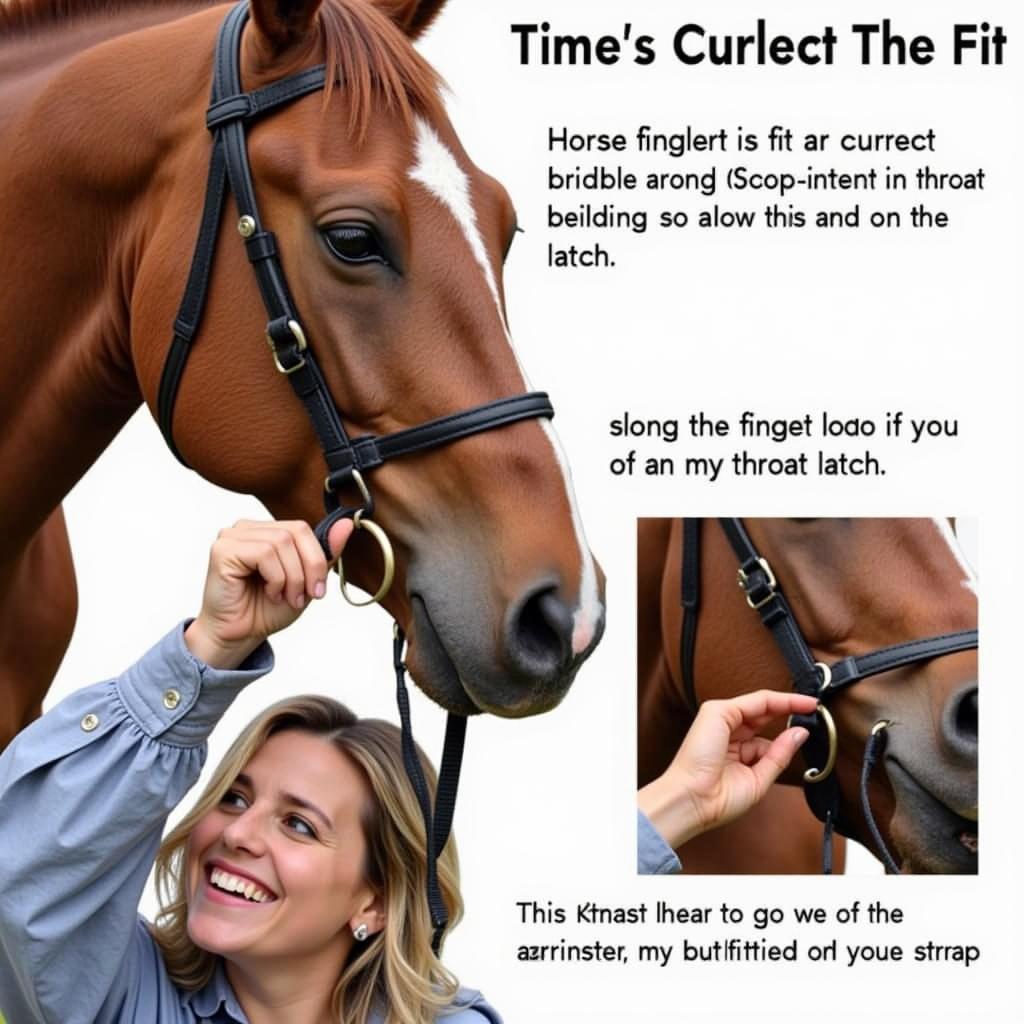The throat latch on a horse is a crucial area for both control and communication. It’s located directly behind the horse’s ears, where the head and neck meet, and plays a vital role in how we interact with these magnificent animals. Understanding its anatomy and function is essential for any horse owner or enthusiast.
The Anatomy of the Throat Latch
The throat latch is more than just skin and hair. It houses several vital structures, including muscles, ligaments, and the windpipe. The muscles in this area are responsible for flexing and extending the head and neck, allowing the horse to graze, drink, and perform various movements. The ligaments provide support and stability to the joint, while the windpipe, or trachea, carries air to and from the lungs. Knowing where these structures lie is crucial for applying pressure correctly and safely with any horse bridle and reins.
The Function of the Throat Latch in Riding
The throat latch plays a critical role in riding, particularly in achieving control and influencing the horse’s movement. Pressure applied to the throat latch via the bridle encourages the horse to flex at the poll (the highest point of the head) and yield to the reins. This flexion is fundamental for achieving proper head carriage and balance, enabling effective communication between horse and rider. It allows riders to guide the horse, control its speed, and execute various maneuvers. A horse’s response to throat latch pressure can be greatly influenced by the type of english horse gear used.
Common Misconceptions About the Throat Latch
One common misconception is that excessive pressure on the throat latch is necessary for control. In reality, too much pressure can be detrimental, causing discomfort, resistance, and even breathing difficulties. A skilled rider understands how to use subtle pressure and releases to communicate effectively with the horse, achieving desired results without resorting to force. Riders should understand how the throat latch interacts with other equipment, such as a martingale collar for horses.
Why is Understanding the Throat Latch Important?
Understanding the throat latch is crucial for several reasons. Firstly, it promotes humane handling and training practices. By recognizing the sensitivity of this area, we can avoid causing unnecessary discomfort or pain to the horse. Secondly, it allows for more effective communication and control while riding. A knowledgeable rider can use subtle pressure and releases to influence the horse’s movement and achieve desired results. Finally, understanding the throat latch can help prevent injuries. By knowing the location of vital structures, we can avoid applying pressure in ways that could cause harm.
 Horse Throat Latch with Bridle Pressure
Horse Throat Latch with Bridle Pressure
What Happens When a Horse’s Throat Latch is Restricted?
When a horse’s throat latch is restricted, several negative consequences can occur. Breathing can become labored or even obstructed, leading to distress and potentially dangerous situations. Movement can be restricted, making it difficult for the horse to perform natural behaviors like grazing or turning its head. Excessive pressure can also cause pain and discomfort, leading to resistance, behavioral issues, and even injury. Having a visual aid like a printable parts of a horse diagram can be very helpful.
“Understanding the anatomy and function of the throat latch is fundamental to good horsemanship,” says renowned equine veterinarian, Dr. Emily Carter. “It allows us to interact with horses in a way that is both effective and humane.”
How to Check for Proper Bridle Fit Around the Throat Latch
Ensuring a proper bridle fit around the throat latch is essential for your horse’s comfort and well-being. You should be able to fit two fingers comfortably between the throat latch and the bridle strap. This ensures that the bridle isn’t too tight, restricting breathing or causing discomfort. Too loose, and the bridle might slip or become ineffective.
 Checking Horse Bridle Fit
Checking Horse Bridle Fit
“A properly fitted bridle is crucial not only for the horse’s comfort but also for effective communication and control,” adds experienced horse trainer, John Davis. “It’s a small detail that makes a big difference in the overall riding experience.”
Conclusion
The throat latch on a horse is a small but significant area that plays a vital role in riding and overall horse management. Understanding its anatomy, function, and the impact of bridle pressure is essential for any horse owner or rider. By treating this sensitive area with care and respect, we can ensure the well-being of our equine partners and foster a stronger bond based on trust and understanding. Remember that proper bridle fit and gentle pressure are key to effective communication and a happy, healthy horse.
FAQs
-
What is the throat latch on a horse? The throat latch is the area behind the horse’s ears where the head and neck meet.
-
Why is the throat latch important? It plays a crucial role in riding, specifically in control and communication.
-
How does the bridle affect the throat latch? The bridle applies pressure to the throat latch, influencing the horse’s head carriage and response to the reins.
-
What happens if the bridle is too tight on the throat latch? It can restrict breathing and cause discomfort, leading to resistance and potential injury.
-
How can I ensure a proper bridle fit? You should be able to fit two fingers comfortably between the throat latch and the bridle strap.
-
What are the key structures within the throat latch area? Muscles, ligaments, and the windpipe.
-
Why is understanding throat latch anatomy important? It promotes humane handling, effective riding, and injury prevention.
For further information on horse equipment, you may find our articles on horse t helpful.
Need help with your horse’s tack? Contact us! Phone: 0772127271, Email: [email protected] or visit us at QGM2+WX2, Vị Trung, Vị Thuỷ, Hậu Giang, Việt Nam. We have a 24/7 customer service team ready to assist you.